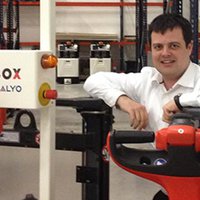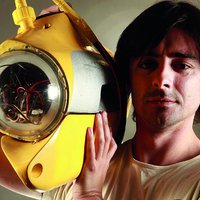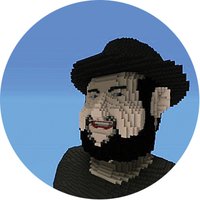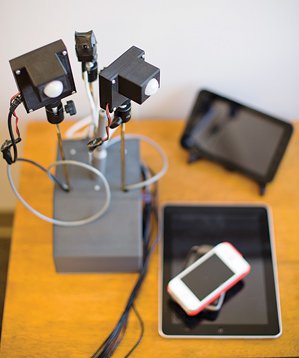Julie Kientz is an expert in human-computer interaction. But unlike many other computer scientists, she spends much of her time far away from a computer screen, figuring out the human side of the equation.
With her people-first perspective on technology, the University of Washington professor is at the forefront of an emerging idea: using relatively simple and common computing tools to improve human health. Kientz has created novel ways of helping people with sleep disorders and families with autistic children, such as a program that uses Twitter to help track key developmental milestones. “I think a lot of people in our area are like, ‘I have a hammer, let’s find a nail,’” says A.?J. Brush, a senior researcher at Microsoft. “She’s really thinking hard about what’s the challenge, how to address it, how do I understand it.”
Kientz’s methods were formed in graduate school at Georgia Tech. Her doctoral advisor, Gregory Abowd, an expert in interactive computing and its use in health care, happens to have two sons with autism. His dedication to them inspired Kientz to investigate technology that could improve their care. But she didn’t begin with the technology. She trained to be a therapist for autistic children and worked as one for a year and a half.
During sessions with an autistic child, a therapist might ask the child to point to a specific item, like an apple, from an array of objects; to imitate a word or gesture; or to copy the therapist’s arrangement of blocks. Therapists use pen and paper to chart the child’s ability to perform such tasks over time.
By working as a therapist and talking to others, Kientz identified problems with the paper-based method. One was that multiple therapists might need to review a child’s records, but there was only one copy of the binder filled with hand-marked charts and notes. And with data points trapped on paper, there wasn’t a good way to visualize broader trends or review negative blips in a child’s otherwise positive progress.
Kientz’s solution was for therapists to use a digital recording pen and special paper that could digitize their writing. The change was unobtrusive to the therapist and invisible to the child. But notes and chart inputs made their way automatically into a database and were synched with video recordings of each session. This meant therapists could project progress graphs at meetings and pinpoint moments when a child didn’t perform as well as expected. They could immediately access video from that moment in a therapy session; in one instance, therapists reviewed the video and agreed that they each had different standards for a “right” response. As a result, the child was given credit for mastering a skill and could move on to new challenges.
To Kientz, this human-centered use of computing was an antidote to frustrating internships she had held as an undergraduate at the University of Toledo, including one at Compaq in which she wrote debugging programs for a microchip. “It was really hard for me to see that connection between what I thought was the really impactful work and what I was doing on a day-to-day basis,” she says, speaking in an office littered with geek ephemera such as a software engineer Barbie doll. (Kientz is married to Washington professor Shwetak Patel, an Innovator Under 35 in 2009.)
Through her work with autistic children, Kientz learned that federal health officials at the Centers for Disease Control and Prevention were looking for ways to spot signs of autism and developmental delays earlier in children’s lives. When she dove in, interviewing parents and doctors, she realized that many families were already recording information the government was looking for, but their formats—snapshots, video, baby books—were hard to integrate with the conventional tracking data gathered by health professionals.
Kientz wondered if there was a way to combine the two kinds of data gathering. That led her to build a computer program called Baby Steps while she was still in grad school. It combined traditional baby-book functions (asking parents to post pictures of sentimental moments like a child’s first trip to the zoo or to Grandma’s house) with ways to record specific developmental milestones (is the baby making eye contact?). Baby Steps has been tested by a handful of families, and Kientz has a $500,000 grant from the National Science Foundation to explore whether the program could scale up to track milestones for any child in Washington state whose parents want to take part.
In this project, too, Kientz is deciding how to develop the technology only after first understanding how people might use it. She found that many Hispanic families in Washington don’t have home PCs and are more likely to go online using phones. So she added phone-friendly features such as the ability to respond to prompts from text messages or Twitter. For example, parents can follow a Twitter account that corresponds to the month their child was born. They might get a prompt that includes an age-appropriate milestone and a code so that their reply will get filed in the database. They might see:
@BabySteps_Nov2012: Does your baby turn his/her head in the direction of a loud noise? #baby68
And then they could respond:
@juliekientz: #Yes #Maya turns her head in the direction of a loud noise #baby68
For another project, Kientz is trying to make it much easier for people with sleep disorders to figure out what’s wrong. Typically, they might have to go to a lab and get loaded up with electrodes for the night; later, they might sit in front of specialized equipment to test things like how their reaction time suffers when they’re experiencing a sleep deficit. Kientz wanted to help people do all this themselves, at home. So she and collaborators from UW’s medical and nursing programs built a prototype called Lullaby. It’s a box with light, temperature, and motion sensors sticking out, wired to a computer and a touch-screen tablet. Patients wear an unobtrusive commercial gadget such as the Fitbit, which tracks exercise by day and sleep patterns by night. They don’t have to fill out sleep logs, which are notoriously inaccurate. And to replace the lab exams measuring reaction times, Kientz’s group developed a smartphone app that lets people test themselves.
Getting inspiration from actual human problems is leading Kientz and her graduate students in surprising directions—such as software they recently developed to help visually impaired people do yoga. “I feel like there’s two routes you can go in research in my field,” she says. “You can help a lot of people in a little way. Or you can help a few people in a big way.”
—Jessica Mintz





